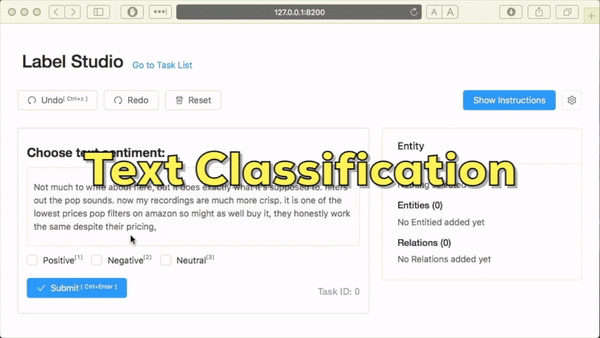Label Studio is an open-source, configurable data annotation tool. Its purpose is to enable you to label different types of data using the most convenient interface with the standardized output format.
- Classify text for sentiment (screenshot)
- Named entities recognition (screenshot)
- Transcribe audio (screenshot)
- Classify audio (screenshot)
- Conversational modeling & chatbots (screenshot)
- Image object detection (screenshot)
- Audio regionsNew (screenshot)
Coming Soon:
- Image line and points (screenshot)
- Image polygons (screenshot)
- Time series (screenshot)
- Video (screenshot)
Label Studio consists of two parts. Backend is a simple flask server that is used to load the data and save the results. The frontend is a React + MST app that is backend agnostic and can be used separately, for example if you want to embed labeling into your applications.
In order to launch server locally, launch
cd backend
bash start.shTo run it locally we include the compiled version of the frontend part and an example implementation of the backend.
Follow this guide for advanced usage & custom configuration
To extend the functionality or embed the labeling inside your app, you need to be able to compile it from the sources.
This guide explains how to do that
- Extensive UI configuration options
- Multiple datatypes supported: images, text, audios
- Hotkeys & History
- Converting to formats accepted by popular machine learning apps (check here for supported GitHub repositories)
Editor configuration is based on XML-like tags. Internally tags are represented by a react view and mobx-state-tree model. Each config should start with a <View></View> tag. Here is an example of a simple text classification config:
<View>
<Text name="text"></Text>
<Choices name="choice" toName="text">
<Choice value="relevant"></Choice>
<Choice value="non relevant"></Choice>
</Choices>
</View>Note that we use tag names to connect tags between each other. Therefore tags that are used for labeling should include a name attribute. And every tag has its own set of parameters. Find more info in the related doc:
Creating your own tags is the suggested way to extend the app and tailor it to your specific needs.
Input should be JSON formatted. All the files that you want to label are expected to be hosted somewhere and provided as an URL in the JSON. The example backend server can process other formats, but it converts any format into the JSON as a result.
Output is JSON. Overall strucutre is the following:
{
"completions": [{
"result": {
"id": "yrSY-dipPI",
"from_name": "sentiment",
"to_name": "my_text",
"type": "choices",
"value": {
"choices": ["Neutral"]
}
}
}],
"data": { "here are your task fields": "" }
}Completion is an object with five mandatory fields:
- id unique id of the labeled region
- from_name name of the tag that was used to label region
- to_name name of the tag that provided the region to be labeled
- type type of the labeling/tag
- value tag specific value that includes the labeling result details
For popular machine learning libraries there is converter code to transform Label Studio format in ML library format. Learn More about it.
This software is licensed under the Apache 2.0 LICENSE © Heartex.


